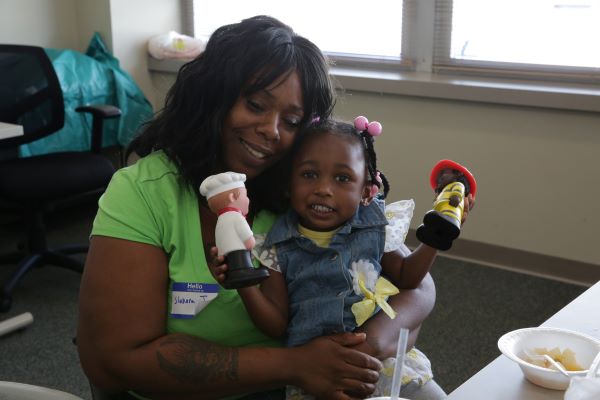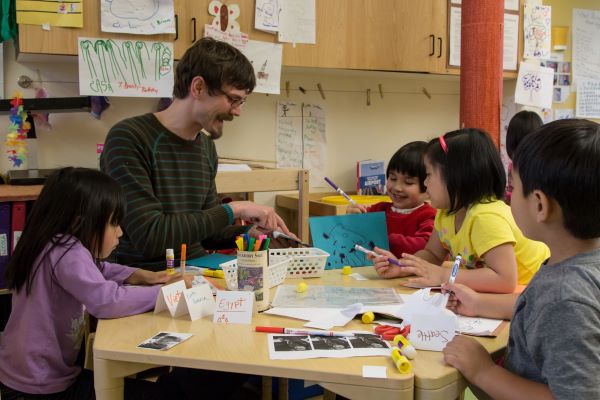Educators can promote the relevance of children’s cultures by making curriculum choices and adaptations that are inclusive and developmentally appropriate for their learners.
Why It Matters

Inclusive individualization is driven by the understanding that even the very youngest child plays a role in designing their learning experiences. Curricula that recognize the unique identity of each child help create a learning environment where culturally relevant activities and experiences help children learn. Involving children in curriculum design means that educators don’t need to be an expert, but instead must be open to learning and modifying practices to respond to child needs.
- An inclusive curriculum is a foundation for effective teaching and home visiting. Children are motivated to learn when curricula and teaching are individualized and culturally responsive.
- An inclusive curriculum carefully considers the abilities, languages, and cultures of each child to plan learning experiences and activities that allow all children to equitably participate.
- From birth, children have daily experiences with people, objects, and places that they store in their memory. Over time, these memories become more complex. This background knowledge is the basis for future learning, and children gain it through their wide and varied interactions with people. Background knowledge includes scientific awareness, cultural norms and expectations, and other information about the world. It expands as children connect new learning to their background knowledge. Children who are dual language learners transfer background knowledge gained in their home language to other languages. Showing interest and making connections with a child’s background knowledge, and offering ways to share what they know, grows a child’s confidence and identity as a learner.
- An inclusive and culturally sustaining curriculum promotes cultural pluralism by including multiple ways of learning, including those of historically devalued cultures. This requires educators to recognize how their beliefs, biases, and experiences influence curriculum choices.
- Family engagement is key to designing culturally sustaining and inclusive curricula. Culturally sustaining curricula ensure that family culture, racial and ethnic identities, traditions, and norms are part of the learning community so children and families can see the program as a place where they belong and are celebrated.
- Home visits offer opportunities for staff to learn about the child’s strengths and interests, observe how the family interacts with their child, and start a dialogue with families about their goals for their child. Information gathered through observations, conversations with families, and socialization activities help staff understand the background knowledge of each child.
Connections to the HSPPS
In this section, learn about example indicators for this Multicultural Principle and how they are supported by the Head Start Program Performance Standards (HSPPS). Think about your program and your learning setting. Then, consider ways you already do these practices and ways you can more closely align to improve your practice.
| Example Indicators | Connections to the HSPPS |
|---|---|
| Adults encourage children to make decisions in their learning. | |
| Adults create a culturally responsive learning environment. | Teaching and the learning environment, 45 CFR §1302.31(b)(2) Education in home-based programs, 45 CFR §1302.35(c)(4) and (d) |
Adults select materials and select topics based on children’s interests. Adults adapt the materials to support successful use by all children and their varying abilities. | Additional services for children with disabilities, 45 CFR §1302.61(a) |
| Staff gather information from families about their culture, languages, and home life. | Parent activities to promote child learning and development, 45 CFR §1302.51(a) |
Example Indicators and Practical Strategies
 Review practical strategies drawn from research and Head Start programs that promote a programs capacity to reflect and affirm the cultures of the children and families it serves.
Review practical strategies drawn from research and Head Start programs that promote a programs capacity to reflect and affirm the cultures of the children and families it serves.
Download the Try It! worksheet and choose one practice to focus on for one month. Use the prompts to thoughtfully plan how you will use the practice. The worksheet also includes tips for reflection after using the practice for one month.
Adults encourage children to make choices in their learning.
Allowing children to make choices and decisions about activities and materials helps them develop confidence in their abilities.
- Maximize learning by following children’s interests, ideas, and curiosities.
- Acknowledge and use the ideas and contributions of children to increase engagement and foster a sense of belonging.
- Follow the child's lead by being flexible enough to adjust the plans to respond to children's interests but still remember the goals for the activity or lesson.
- Plan for child-led studies, conversations, and storytelling and design learning environments with materials that build on children’s interests, so they engage in joyful play.
- Adapting materials and activities to support varying abilities and successful use (e.g., taping paper to a table or adding grips to writing tools).
- Support families to recognize and follow their child’s lead, model ways to provide the child choices and to extend their learning when they show curiosity in an object or activity.
Adults create a culturally responsive learning environment.
Culturally responsive learning environments help nurture belonging and a strong sense of self and social identity.
- Reflect children’s social identities through diverse books, learning materials, family pictures, and children’s artwork.
- Represent the different languages and cultures of children in the books and printed materials children see in the classroom.
- Include books that focus on different aspects of diversity, such as family structure, gender diversity, and disabilities.
- Model and teach respect for differences in identity with learning experiences.
- Use visual supports to help children understand learning environment organization and routines, and to engage in learning activities.
- Use keywords and phrases in each child’s home language to guide their engagement with peers and adults.
- Encourage families to use home language with their child and to share explanations for family routines and traditions.
 Adults choose materials and explore topics based on children’s interests.
Adults choose materials and explore topics based on children’s interests.
- Provide opportunities for children to explore using all their senses.
- Offer open-ended toys, like boxes and blocks, which can be used in a variety of ways.
- Give materials and time for children to follow their interests, create, and explore.
- Change plans if children initiate a more interesting idea or experience.
- Ask open-ended questions and keep the rich conversations going.
- Include familiar objects and materials, like items children have at home, for their use in the learning environment.
- During home visits use objects and materials in the home to extend learning based on children’s interests. Talk with families about what they notice when children are engaged in play for extended periods of time. Use this information to offer similar experiences that expand their learning or practice of a new skill.
Gather information from families about their culture, languages, and home life.
- Use home visits to learn about the child’s skills and interests from the family.
- Talk with families about the ways their child learns and communicates in the home.
- Encourage families to share how they teach their children at home, to use similar strategies in the program setting.
- Ask about the family's traditions, culture, values, and beliefs related to learning and education.
- Invite families to share their culture with children in the classroom, in socialization groups, or with staff.
Voices from the Head Start Community
In this section, an Early Head Start teacher uses translation tools and an interpreter to build relationship with a parent to provide culturally sustaining care for a child.
Staff in an Early Head Start program had concerns about a 9-month-old infant who did not yet roll over or sit up by herself. At first, communication with the mother who was from Ghana and spoke little English, was difficult. The mother seemed unsatisfied with the care the program provided her daughter. She appeared unconcerned about the gross motor delay. The teacher used the ideas below to build a relationship with the mother.
Communicate frequently using multiple methods.
Through informal daily exchanges, the teacher built a relationship with the mother while caring for her infant. Sometimes the teacher would send short written notes home using translation software. The mother would then write notes back that the teacher would translate. For home visits and conferences, the program hired an interpreter to help with communication. The teacher learned that this mother used a long piece of fabric to keep the baby wrapped around her body most of the time because she came from a family where you don’t put a baby down on the ground.
Understand expectations and concerns.
Once the teacher learned this important piece of information, she helped the mother feel more comfortable about the care her baby was receiving. She explained why they put babies on the ground for tummy time. The teacher asked the mother’s permission to use plans she had made for the baby. If the mother didn’t want the baby on the floor, would it be okay to place her on a firm mat with someone right next to her? That was OK with the mother, but she was concerned that the baby needed to be held more often. Because the infant room had many volunteers, it was easy to meet this request. Teachers and volunteers held the baby as much as possible and in ways that supported her gross motor development. They played bouncing games on their laps, laid her across their legs on her stomach, and gave her large objects to hold. The program bought a second foam mat for the mother to use at home.
Through communication, patience, and an open mind, the teacher built a relationship with the mother and created opportunities for this baby to improve her motor skills. In turn, the mother shared her beliefs that babies should be frequently held. Respecting this practice, the teacher added it to her lesson planning.
Reflect
Early childhood programs can use the following questions as a starting point — to take a look at the challenges they face and the approaches they might use to promote culturally sustaining and equitable practice across service delivery areas. The questions listed below are designed for self-reflection and critical assessment of practice and can also be used with groups of staff, with families, and with community partners to spark dialogue. In order to go deeper into some topics in a group setting, programs may benefit from session leaders who are skilled facilitators either among their staff or from outside their program.
- How does your program include families in curriculum planning?
- How does the program ensure the full participation of all children including children with disabilities and children who are dual language learners?
- How are needed adaptations to curriculum and learning environments identified?
- What resources are available to staff (e.g., materials, equipment, planning time, consultants) to implement these adaptations?
Deepen Your Learning
Explore these useful resources to learn more about ways to make sure curriculum supports the full participation and inclusion of all young learners.
- Curriculum Basics
- Curriculum Modification: An Overview
- Implementing a Curriculum Responsively: Supporting Children’s Development and Learning
- Responsive Learning Experiences and Interactions
- Developmentally Appropriate Practice
- Planned Language Approach
- Responsive Learning Environments
- Developmental Milestone Expectations in Early Head Start
- Implement Developmentally Appropriate Curriculum
Read more:
Resource Type: Article
National Centers: Early Childhood Development, Teaching and Learning
Audience: Directors and Managers
Last Updated: March 19, 2024